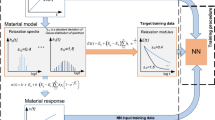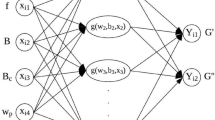Abstract
Dynamic mechanical analysis is a method to characterize the frequency domain viscoelastic properties including storage and loss moduli. Methods have been developed to transform these properties to time domain and extract elastic modulus over strain rates, which is useful in mechanical design. However, application of these methods becomes increasingly complex for materials containing multiple thermal transitions. Neural networks can provide advantages in solving such problems. As the form of radial basis neural network satisfies the form obtained from time–temperature superposition principle, it is used in the present work with back-propagation to establish the master relation of loss modulus. The influence of regulation factor and neuron number is investigated to find the best parameter set. Then, storage modulus is divided into frequency-dependent and frequency-independent part. Both parts are individually calculated from loss modulus using Kramers–Kronig relation. The linear integral relation of viscoelasticity can transform the storage modulus into time-domain relaxation modulus, which can predict the stress response with specific strain history and temperature. The transformation is tested on ethylene–vinyl acetate. The time-domain elastic properties are extracted and compared with those from tensile tests at room temperature. The transformation achieves an average root mean square error of 3.3% and a maximum error 4.9% between strain rates 10−6 to 10−2 s−1. This process can predict the properties at a wide range of temperatures and frequencies from a single specimen and can be implemented using parallel computing, which is promising for complex material systems.












Similar content being viewed by others
References
Polak-Kraśna K, Dawson R, Holyfield LT, Bowen CR, Burrows AD, Mays TJ (2017) Mechanical characterisation of polymer of intrinsic microporosity PIM-1 for hydrogen storage applications. J Mater Sci 52(7):3862–3875. https://doi.org/10.1007/s10853-016-0647-4
Lai J-C, Li L, Wang D-P, Zhang M-H, Mo S-R, Wang X, Zeng K-Y, Li C-H, Jiang Q, You X-Z, Zuo J-L (2018) A rigid and healable polymer cross-linked by weak but abundant Zn(II)-carboxylate interactions. Nat Commun 9(1):2725
Feng J, Guo Z (2016) Effects of temperature and frequency on dynamic mechanical properties of glass/epoxy composites. J Mater Sci 51(5):2747–2758. https://doi.org/10.1007/s10853-015-9589-5
Helgeson ME, Moran SE, An HZ, Doyle PS (2012) Mesoporous organohydrogels from thermogelling photocrosslinkable nanoemulsions. Nat Mater 11:344
Zhang Y, Nanda M, Tymchyshyn M, Yuan Z, Xu C (2016) Mechanical, thermal, and curing characteristics of renewable phenol-hydroxymethylfurfural resin for application in bio-composites. J Mater Sci 51(2):732–738. https://doi.org/10.1007/s10853-015-9392-3
Lieleg O, Kayser J, Brambilla G, Cipelletti L, Bausch AR (2011) Slow dynamics and internal stress relaxation in bundled cytoskeletal networks. Nat Mater 10:236
Shunmugasamy VC, Pinisetty D, Gupta N (2013) Viscoelastic properties of hollow glass particle filled vinyl ester matrix syntactic foams: effect of temperature and loading frequency. J Mater Sci 48(4):1685–1701. https://doi.org/10.1007/s10853-012-6927-8
Ferry JD (1980) Dependence of viscoelastic behavior on temperature and pressure. Viscoelastic properties of polymers. Wiley, New York
Zeltmann SE, Bharath Kumar BR, Doddamani M, Gupta N (2016) Prediction of strain rate sensitivity of high density polyethylene using integral transform of dynamic mechanical analysis data. Polymer 101:1–6
Zeltmann SE, Prakash KA, Doddamani M, Gupta N (2017) Prediction of modulus at various strain rates from dynamic mechanical analysis data for polymer matrix composites. Compos B Eng 120:27–34
Xu X, Gupta N (2018) Determining elastic modulus from dynamic mechanical analysis: a general model based on loss modulus data. Materialia 4:221–226
Romero PA, Zheng SF, Cuitiño AM (2008) Modeling the dynamic response of visco-elastic open-cell foams. J Mech Phys Solids 56(5):1916–1943
Luong DD, Pinisetty D, Gupta N (2013) Compressive properties of closed-cell polyvinyl chloride foams at low and high strain rates: experimental investigation and critical review of state of the art. Compos B Eng 44(1):403–416
Peroni L, Scapin M, Fichera C, Lehmhus D, Weise J, Baumeister J, Avalle M (2014) Investigation of the mechanical behaviour of AISI 316L stainless steel syntactic foams at different strain-rates. Compos B Eng 66:430–442
Koomson C, Zeltmann SE, Gupta N (2018) Strain rate sensitivity of polycarbonate and vinyl ester from dynamic mechanical analysis experiments. Adv Compos Hybrid Mater 1(2):341–346
Xu X, Koomson C, Doddamani M, Behera RK, Gupta N (2019) Extracting elastic modulus at different strain rates and temperatures from dynamic mechanical analysis data: a study on nanocomposites. Compos B Eng 159:346–354
Jia Z, Amirkhizi AV, Nantasetphong W, Nemat-Nasser S (2016) Experimentally-based relaxation modulus of polyurea and its composites. Mech Time-Dependent Mater 20(2):155–174
Lin KSC, Aklonis JJ (1980) Evaluation of the stress-relaxation modulus for materials with rapid relaxation rates. J Appl Phys 51(10):5125–5130
Xu X, Gupta N (2018) Determining elastic modulus from dynamic mechanical analysis data: reduction in experiments using adaptive surrogate modeling based transform. Polymer 157:166–171
Xu X, Gupta N (2019) Artificial neural network approach to predict the elastic modulus from dynamic mechanical analysis results. Adv Theory Simul. https://doi.org/10.1002/adts.201800131
Butler KT, Davies DW, Cartwright H, Isayev O, Walsh A (2018) Machine learning for molecular and materials science. Nature 559(7715):547–555
Ning L (2009) Artificial neural network prediction of glass transition temperature of fluorine-containing polybenzoxazoles. J Mater Sci 44(12):3156–3164. https://doi.org/10.1021/ci010062o
Lin YC, Fang X, Wang YP (2008) Prediction of metadynamic softening in a multi-pass hot deformed low alloy steel using artificial neural network. J Mater Sci 43(16):5508–5515. https://doi.org/10.1007/s10853-008-2832-6
Shabani MO, Mazahery A (2011) Modeling of the wear behavior in A356–B4C composites. J Mater Sci 46(20):6700–6708. https://doi.org/10.1007/s10853-011-5623-4
Malho Rodrigues A, Franceschi S, Perez E, Garrigues J-C (2015) Formulation optimization for thermoplastic sizing polyetherimide dispersion by quantitative structure–property relationship: experiments and artificial neural networks. J Mater Sci 50(1):420–426. https://doi.org/10.11648/j.am.20180704.14
Dey P, Gopal M, Pradhan P, Pal T (2017) On robustness of radial basis function network with input perturbation. Neural Comput Appl. https://doi.org/10.1007/s00521-017-3086-5
Booij HC, Thoone GPJM (1982) Generalization of Kramers-Kronig transforms and some approximations of relations between viscoelastic quantities. Rheol Acta 21(1):15–24
Dorffner G (1992) EuclidNet—a multilayer neural network using the euclidian distance as propagation rule. In: Aleksander I, Taylor J (eds) Artificial neural networks. North-Holland, Amsterdam, pp 1633–1636
Goodfellow I, Bengio Y, Courville A (2016) Deep learning. Adaptive computation and machine learning series. The MIT Press, Cambridge
Christensen RM (1982) Theory of viscoelasticity: an introduction. Dover Civil and Mechanical Engineering, 2nd edn. Academic Press, New York
Acknowledgements
This work is supported by the Office of Naval Research N00014-10-1-0988. Dr. Mrityunjay Doddamani of NITK, Surathkal, India, is thanked for providing the EVA samples used for generating experimental results.
Author information
Authors and Affiliations
Corresponding author
Ethics declarations
Conflict of interest
The authors declare that they have no conflict of interest.
Additional information
Publisher's Note
Springer Nature remains neutral with regard to jurisdictional claims in published maps and institutional affiliations.
Rights and permissions
About this article
Cite this article
Xu, X., Gupta, N. Application of radial basis neural network to transform viscoelastic to elastic properties for materials with multiple thermal transitions. J Mater Sci 54, 8401–8413 (2019). https://doi.org/10.1007/s10853-019-03481-0
Received:
Accepted:
Published:
Issue Date:
DOI: https://doi.org/10.1007/s10853-019-03481-0




